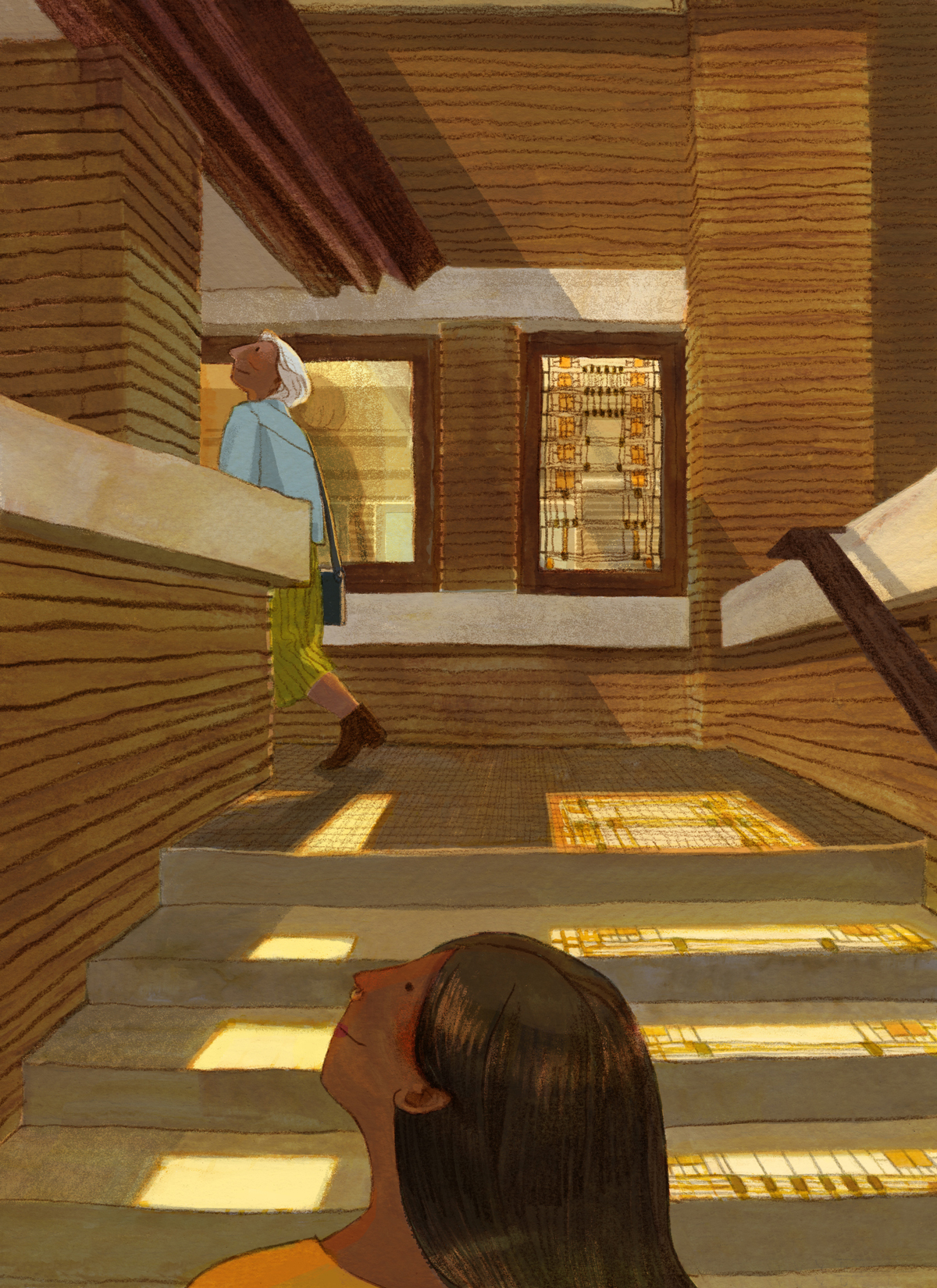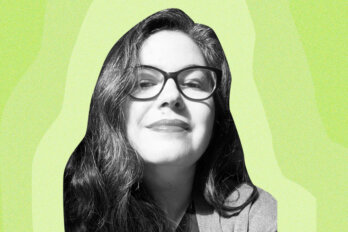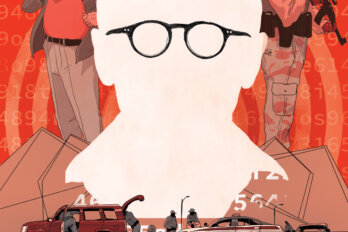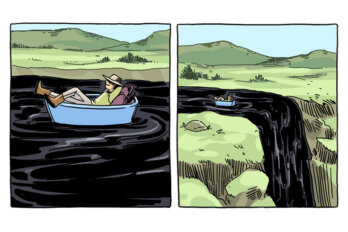Listen to an audio version of this story
For more audio from The Walrus, subscribe to AMI-audio podcasts on iTunes.
As kids, my younger brother and I would snicker whenever my mother stopped to run her palms over what she thought was an exciting bit of a building. It could have been a limestone handrail at a shopping mall, a granite column at an old bank, or reclaimed wood at a hipster restaurant; sometimes, she would take our little hands and guide us to do the same. To this day, I can walk into a room and estimate its ceiling height because she taught us how to assess the highness and lowness of rooms. I’m also well versed in the slip resistances (a technical term for slipperiness) of a variety of flooring substrates. Believe me when I say that my mother really, really likes buildings.
My mother is an architect. At eighteen, she enrolled in architecture at Bangladesh University of Engineering and Technology, a program—and profession—bereft of women. She then worked in Dhaka, the Bangladeshi capital, and Bauchi, Nigeria, before coming to Canada in 1988. She has a strong technical background in hospital and long-term care design (she was on the master planning team for Toronto’s University Health Network and was one of the design leads for Humber River Hospital), but Mum’s personal taste has always skewed to the artist’s side. At her drawing table, this translated into humanizing details, like indoor gardens or window angles keyed to let in more light—and, of course, her love of texture and materials.
Once my mother had inspected most of Toronto’s surfaces, family expeditions turned south of the border, to landmarks she had studied at university in Bangladesh, the country where she and I were born. In cities like Chicago and New York and Philadelphia, we took in—and, where we could, touched—sleek steel-and-glass structures, the carved concrete of art deco facades, and modern entryways by some of the world’s greatest designers, including one of my mother’s favourites, Frank Lloyd Wright. In the fall of 2000, after consulting CAA maps and guidebooks from the library, my mother planned a kid-free trip for herself and my dad to see one of Wright’s most famous works. Her plan was to reach the iconic Fallingwater, in Pennsylvania, in a two-day drive. But it would be almost two decades before Mum was able to access the site in the way she’d imagined.
In the summer of 2019, after returning from a long road trip, I told Mum that I was eager to do a multiday drive and just needed a destination. She responded that, for years, she had been wanting to retrace that route to Fallingwater. But she’d never had the time, the energy to plan, or a travel buddy to do it with.
Listen to an audio version of this story
For more audio from The Walrus, subscribe to AMI-audio podcasts on iTunes.
I’d heard about the ill-fated trip in snippets before, minus several damning details. My parents’ marriage was (as I remember it and as Mum tells me) always difficult, and this excursion followed that vein. My mother later told me she had found herself crying to sleep every night during their self-guided tour, including one night in the back of our family van, which was parked on the side of the road because her then husband had failed to book a hotel. She also told me she had been deprived of certain key sites that charged entry fees. And she had felt rushed, as if the trip were a chore rather than an experience to be savoured. Within two years, my parents had separated, and my dad became entirely estranged from our lives. I haven’t had any real contact with him since I was a teen, and with no way to reach him, I am able to present only my mother’s side of this experience.
It is both unsettling and enlightening to see your parent’s vulnerabilities, their soft spots of loneliness, of regret, of want. I’ve been my mother’s closest companion since I was a teenager, so I am under no pretence that mothers are indestructible, but I still hate sensing her fragility.
Within a month of the road trip conversation, I mentioned her interest in visiting Wright sites to a friend who happened to be a former architecture journalist and whose partner was a long-time member of the Frank Lloyd Wright Foundation, an organization that preserves several Wright buildings. Within days, the pair sent me a draft itinerary, and two weeks later, all four of us—the friend, his partner, my mother, and I—started a Frank Lloyd Wright trip that took us from western New York to western Pennsylvania, with visits to seven Wright-designed buildings along the way.
While this was ostensibly a treat meant for Mum, I found myself caught up in the pilgrimage as well. Walking through the halls of each house, I thought about not only Wright’s life and design choices but also my mother’s. Wright died in 1959 (the year my mother was born), and I can draw few parallels between these two architects as people. But it wasn’t until I learned about how Wright related to his homes that I began to understand the one my mother had created for us.
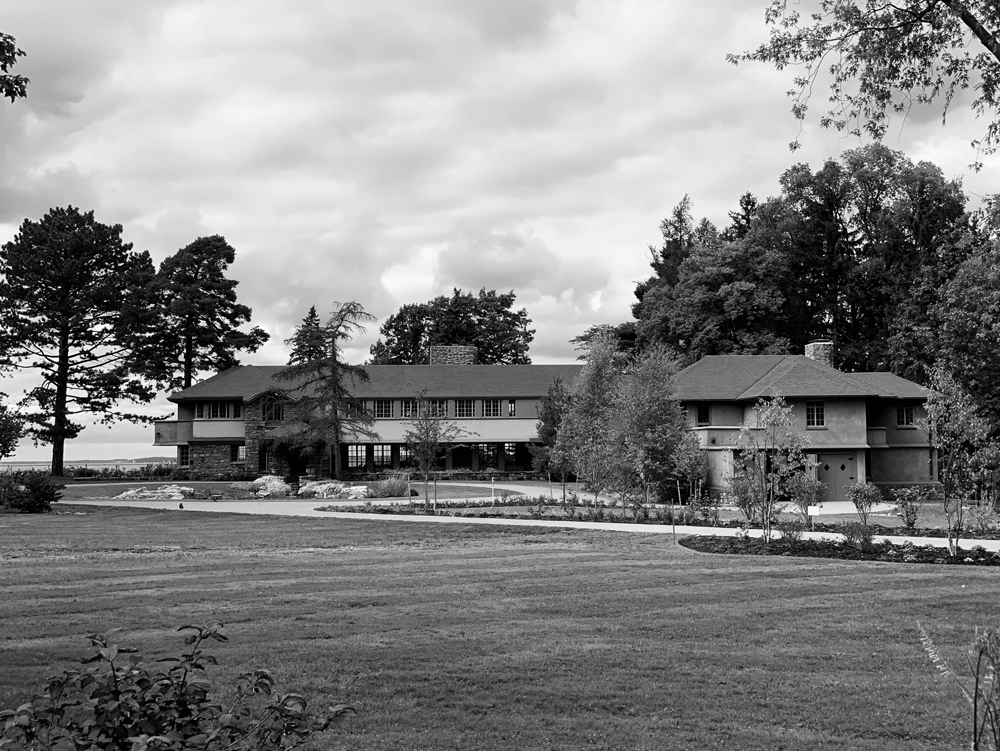
My first Wright experience was at the Darwin D. Martin House Complex, a set of ochre-brick buildings on a massive corner lot in an affluent suburb of Buffalo, New York. Wright scaled homes, regardless of whom they were for, to his own height—five feet, eight and a half inches. I found the rooms, whose door frames hovered less than a foot from my head, cozy and cute; one of my travelling companions, whose head grazes the six-foot-four mark, did not.
Though Wright is known for iconic public designs, like the Guggenheim Museum in New York, the vast majority of his work consisted of single-family residences. In describing the standard style of home being built in the US during his time, Wright wrote that it “lied about everything”—it had no unity, merely a series of boxes within boxes. A Wright home, he contended, was harmonious, flowing from room to room and outside with a fluidity that reflected Wright’s idea of how families should function.
The irony is that Wright, who had eight children from three marriages, would never know a happy family life. In his autobiography, Wright notes that he never felt a connection to his own father, who walked out on his family when his eldest son graduated from high school. Apparently echoing his father’s ambivalence toward parenthood, Wright once wrote, “I am afraid I never looked the part. Nor ever acted it. I didn’t feel it. I didn’t know how.” His second oldest child, John Lloyd Wright, echoed this sentiment in his book My Father, Frank Lloyd Wright, noting that the senior Wright had likely never wanted children but, at the very least, built a large playroom for the ones he had. It was as if, by creating an idealized space for a family, he could compensate for its absence in his real world.
I’ve now seen my mother renovate three personal residences, the most recent her three-storey home in Toronto’s Little Italy, a residential neighbourhood of detached and semidetached brick houses originally built by and for middle- and lower-class families. Always, the kitchens are expanded and furnished with restaurant-quality appliances—fitting for us, a food-focused family. And, on the same floor, Mum reserves a large, open living-dining layout, with long tables that can seat eight or ten people and cupboards that hold nearly forty wine glasses and special bowls for ice cream. The receiving areas are adorned with art and plush couches, with space to hang a dozen coats, as though she is readying her home for entertaining scores of people—but this she rarely does.
Like Frank Lloyd Wright, she may be arranging her abode not for current needs but to evoke an idea of a model household.
My mother’s layouts match what I’ve heard of her childhood home, in Bangladesh, where her father would regularly host colleagues from the UN or his tennis-club buddies. She remembers that the guest room was always occupied by some uncle, a friend’s niece, or a student awaiting a spot at the university residence. Her recollections are full of festivities and gaiety, busy memories that are so different from my own adolescence. She doesn’t seem to realize, even as we visit Wright’s famous houses, that, like the iconic architect, she may be arranging her abode not for current needs but to evoke an idea of a model household—one informed by the home she left behind.
I have heard a host of stories from my mother’s first days in Canada, but one of my favourites is about how Mum came upon her first architecture gig in this country. Not long after we arrived, she left my brother and me in our father’s care, stepped out of the tiny apartment she was trying to make into a home, crossed Bloor Street West, and walked into the office of architect Arthur Erickson. She knew of Erickson (who died in 2009) in much the same way she knew of Wright: she had studied his work at school, which is what she had told the receptionist when she had called to request an office tour. When she was led into Erickson’s personal office (he was not present at the time), she slid a very short, very handwritten resumé onto his desk. A month later, the office manager called to offer her a junior position. To this day, Mum isn’t sure whether it was because Erickson was impressed by her tenacity or because, upon finding her CV, he simply assumed he must have offered her a gig at some point.
This job was within walking distance of our little apartment on Irwin Avenue, just north of downtown Toronto. From her desk on the sixteenth floor, Mum could see the yard of Jesse Ketchum Public School, where my brother and I were enrolled in daycare. I can just picture her, in a mint-green silk skirt suit set, sketching designs and looking out over the schoolyard we played in. I wonder where my family would be now had my mum not gotten that proximal advantage that saved her from having to choose between work and mothering. Mum continued to ascend in her field, eventually becoming financially able to support us on her own after she left my dad.
As she manoeuvred through her career and new roles required longer hours and travel, she sometimes had to put her job over her role of a parent. She wasn’t always there for school functions or holiday breaks. She also missed out on less celebratory occasions: she didn’t know that I was routinely bullied in high school or that, while she spent weeks or months at a time on projects in New York, Shanghai, and Dubai, her teenage kids were figuring out how to cook by watching Food Network.
As I grow older, I find myself more and more interested in talking to my mother about that period of our lives. Sometimes, it’s because I’m curious about a detail, like how long I slept in her room after watching The Ring. (I maintain that it was a few months; she, preposterously, claims it was nearly twelve.) Other times, it’s because I want to understand the version of her when she was the age I am now. These conversations aren’t necessarily sweet, sentimental trips down memory lane: my mother can be alternately affronted and defensive when I try to revisit the past. Her grievance is usually with the mere suggestion that she, in some way, abandoned her children. The thing is, I never felt abandoned, and I never used that term. I tell her that I am proud of how we managed—she, my brother, and I—through that difficult time. Not completely mollified, she’ll offer the adage that, whatever she did, she did it only for us. Which makes me wonder, Is that the whole truth? And does it need to be?
For racialized people and those coming from poorer, non-English-speaking countries, immigration carries a certain mythology. It is a story that immigrants and Canadians collectively laud, the arc about the engineer-or-doctor-back-home who drives a cab to put their kids through university, possibly to become engineers or doctors themselves in their new country. At the centre of this narrative is the sacrifice of the first-generation immigrant, their selflessness in leaving the land they knew for this cold one, in passing on their dreams for another generation to fulfill. Of course, this narrative cannot apply to every immigrant family. But it has affected us in the way my mother still harbours guilt for doggedly pursuing a career not only as a woman but as a brown, immigrant, single mother. And perhaps it is also why she didn’t come to me earlier, when she needed help retracing her steps to Fallingwater—and finding her own, personal, selfish, and deserved happiness.
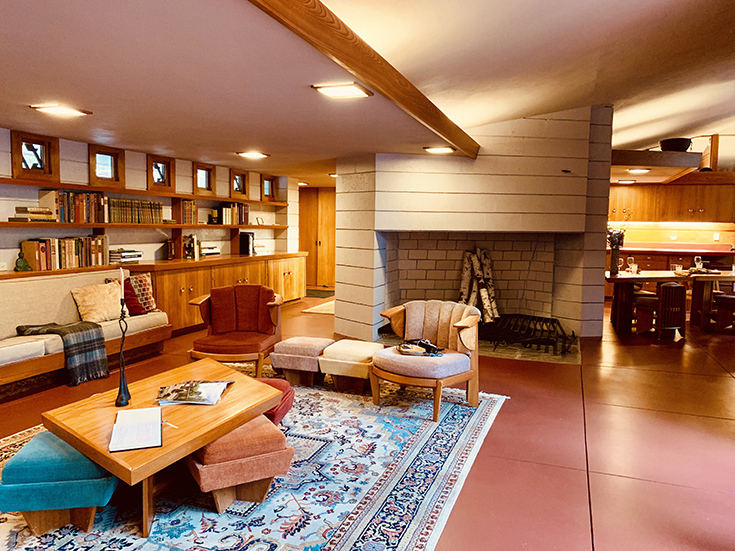
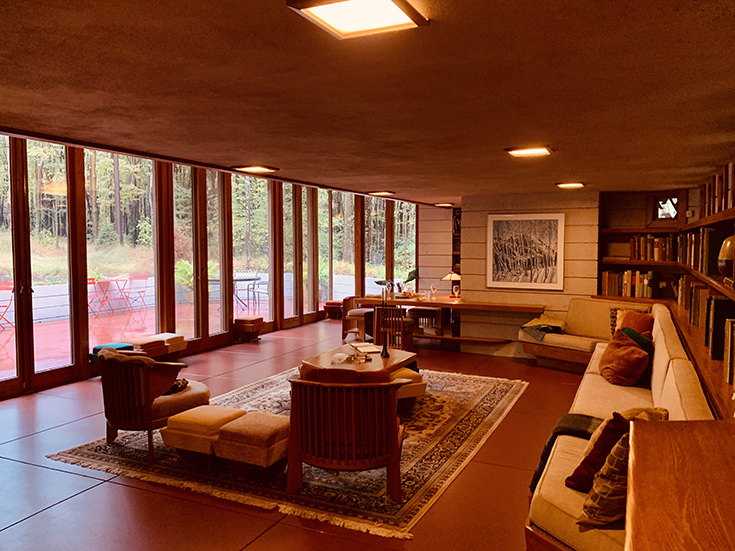
A Wright site is usually like a museum: visitors, herded by tour guides into the centres of rooms or balconies so as not to disturb anything, can’t get too close to the furniture and decor. Even at Fallingwater—the spot that had motivated Mum’s initial road trip—she had to keep her hands to herself. The outlier for us was Polymath Park, a sort of Disneyland for Frank Lloyd Wright fans and our final stop. There are four structures on the property, two by Wright and two by his apprentice. We stayed in one overnight, before our final event: a private dinner at Mäntylä House, a home by Wright that was relocated from Minnesota and rebuilt, tile by tile, on the Polymath site, in Pennsylvania. Diners at Mäntylä have to interact with the art since the multicourse meal is served at an original Frank Lloyd Wright table. Here, finally, Mum could express her tendency to touch, which, after days of carefully containing her arms and hands, was released with abandon upon the hodgepodge collection of Wright-designed furnishings and fixtures. It was here, while we perched on diamond-shaped velvet stools in soft desert colours, that I inquired why she hadn’t asked me to redo this trip with her sooner. “You have your own trips to take,” she answered.
Moments later, I carefully pulled out a low-backed barrel chair—one of Wright’s most recognizable designs—to seat myself for dinner as Mum continued to talk shop with our companions and the tour staff (punctuated, of course, with the pat of a beam or the rub of a finial). Her back was to a wall of windows, the panes five times as tall as they were narrow, much like the forest of skinny trees visible between the frames. This is common in Wright’s buildings, that the inside should mimic or complement the outside (Fallingwater has a stream running from the front walkway into the living room), a style he dubbed “organic architecture.”
So much of what Wright envisioned was rooted in approximation: of nature, of a perfect household, of an idealized version of America. I wonder, then, What would the house look like if it were true to his lifestyle rather than to his lofty fabrications? Would he have included extra bedrooms at the back, for a client’s wife with whom he was known to have had an affair, in lieu of the playrooms and fireplaces he thought necessary for a family he created in his mind?
I think of my mother’s homes and our family life. Mum’s house could more accurately reflect our family’s reality, where a four-top table and a single set of dishware would suffice. It is also a painful reminder that, for all her measurable successes and achievements—checks on the immigrant scorecard that have afforded us many privileges—there remain less tangible, unfulfilled desires on her personal lists.
It isn’t fair, though, to brand her designs and her hopes as inaccurate or, even worse, unattainable. To do so would be to limit my mother to that myth, the immigrant identity shaped by necessity. Razing that belief means I need to see the homes Mum has built in the way Wright had envisioned: more symbolically, as a blueprint for the family we want to be. The homes she created are not a lie but a wish.

